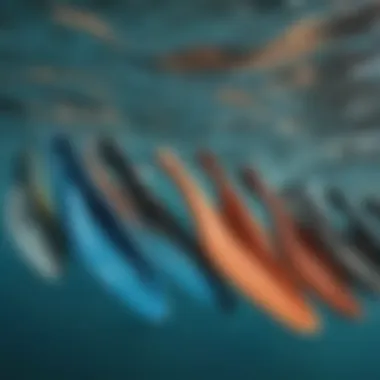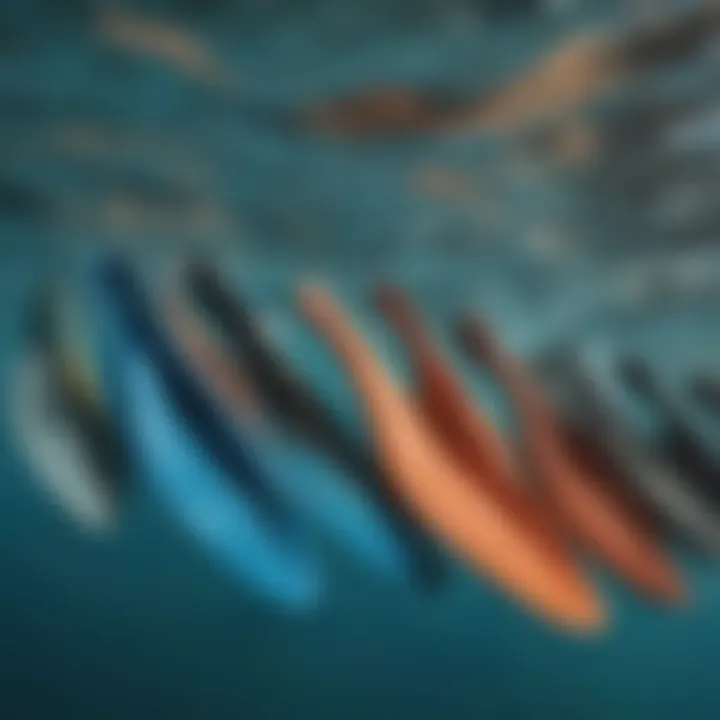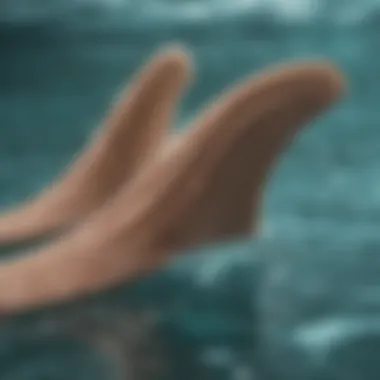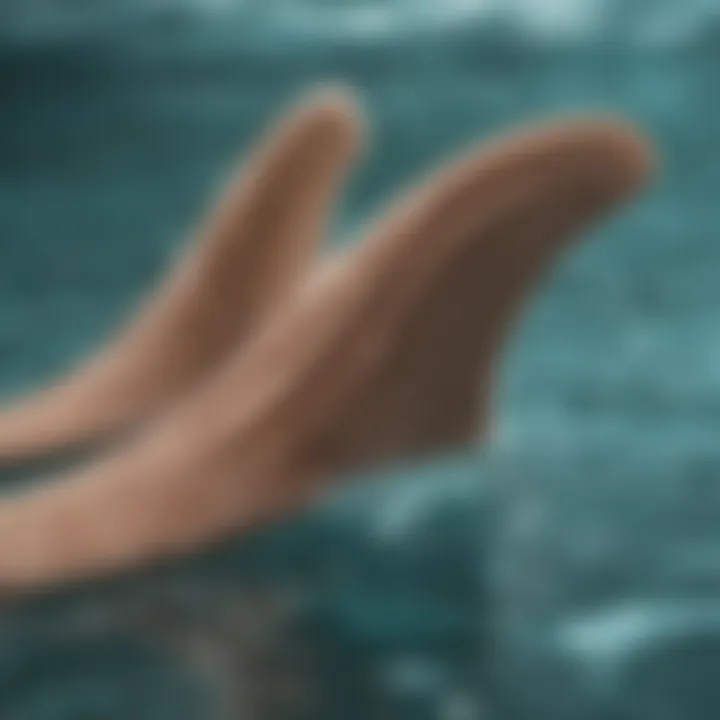A Comprehensive Guide to Swimming Fin Sizes


Intro
This comprehensive guide will delve into the intricacies of how fin sizes affect various swimming techniques, beginner to advanced. Additionally, it offers insights into safety and gear, ensuring that every enthusiast—whether a novice or a seasoned athlete—can make informed choices about their swim gear.
Whether you’re training for a competition or just enjoying a leisurely afternoon at the pool, knowing the right fin size can lead to gains in technique and efficiency. Let’s dive deeply into the world of fins and discover how to navigate this essential part of aquatic adventures.
The Role of Fins in Aquatic Sports
Fins are not just a nifty accessory for swimmers; they play a crucial role in enhancing performance and efficiency in the water. Whether you’re gliding through a calm lake or navigating waves at a beach, fins can vastly change one's interaction with the aquatic environment. They act like extensions of the swimmer's body, providing increased propulsion and reducing the energy needed to move through water. For competitive swimmers, they can mean the difference between winning and losing a race, while for recreational swimmers, they can enhance enjoyment and improve skills.
Fins also allow swimmers to focus on their technique. By adjusting kicking styles and promoting proper body alignment, fins encourage best practices that often translate to improved performance when not wearing them. They can enhance the experience of underwater activities like diving, snorkeling, or freediving by not only assisting propulsion but also helping users remain in fluid motion with less effort.
It is worth noting that not all fins are created equal. Different types cater to diverse needs and levels of skill, and understanding their particular role is essential when selecting the right fin. It’s a matter of finding a balance between function, comfort, and personal objectives in aquatic sports.
"A swimmer without fins is like a bird without wings — sleek but limited."
Moreover, the choice of fins can affect comfort levels during prolonged use. Swimmers must also consider the fin’s fit since an ill-fitting pair might lead to blisters, discomfort, and ultimately a less enjoyable experience. Selecting the right type of fin based on one's activities and capability level is crucial, as this directly ties into both performance and enjoyment in aquatic sports.
In summary, fins are not an afterthought; they are essential tools that enhance the swimmer's experience, drive efficiency, support technique, and can ultimately help turn a good swim into a great one.
Anatomy of Swimming Fins
The structure of swimming fins plays a pivotal role in their effectiveness and suitability for various aquatic activities. Understanding the anatomy of these fins is key to optimizing performance. Two crucial components contribute significantly to how fins operate: blade length and width, and foot pocket design. Each element has its own set of advantages and disadvantages that can affect a swimmer's experience. As we dive deeper, we’ll see how these features can cater to individual preferences and enhance swimming technique.
Blade Length and Width
The length and width of a fin’s blade directly correlate with propulsion and maneuverability in the water. When the blade is longer, it generally provides greater surface area, allowing swimmers to push more water with each kick. This can result in increased speed. For instance, a long-fin swimmer might go zipping past you like a dolphin when he’s got those fins on, while someone using shorter fins might feel like they are just treading water. However, long fins are not without their drawbacks. They can easily become cumbersome for some individuals.
In terms of width, a wider blade can give additional thrust, but it can also sacrifice agility. Narrow blades, conversely, offer more precision with turns and technical maneuvers. So, the choice between long and short—or wide and narrow— hinges on personal preference and the specific swimming discipline:
- Long and Wide Blades: Great for speed and straight-line swimming.
- Short and Narrow Blades: Ideal for freestyle and technical swimming, enhancing control.
Choosing the right blade size involves understanding your needs, from fitness swimming to competitive performance. The blade’s shape can also affect water flow, making it essential to find something that feels right for your style.
Foot Pocket Design
Often overlooked, the foot pocket’s design is equally as important as the blade. A comfortable and well-fitting foot pocket ensures that fins remain secure during use. If your foot slips around in the pocket, you aren’t getting the most out of your kicks. It could lead to inefficiencies, slowing you down in the water.
Designs vary significantly: some feature open heels, while others adopt a full foot pocket approach. Open-heeled fins allow for greater flexibility and breathability, which might be essential for long sessions in the water. However, full foot pockets usually provide a snugger fit, which can enhance control and responsiveness. Personal comfort in the foot pocket can make or break a swimming session.
Here are some factors to consider regarding foot pocket design:
- Material: Softer materials can offer better comfort but may wear out quicker.
- Shape: Ergonomically designed foot pockets are often preferable, but personal foot shape varies widely.
- Sizing: Always double-check sizes, as different brands can have slightly different measurements.
"In essence, the anatomy of swimming fins—both blade and pocket—is critical in tailoring your swimming technique and comfort. A few small adjustments might lead to a world of difference in your aquatic adventures."
Understanding these anatomical aspects not only enriches your knowledge but also arms you with the insight needed to make informed choices about swimming fins. Whether you’re just splashing about for leisure or gearing up for a competition, the right fin anatomy can propel you towards greater efficiency and enjoyment in the water.
Importance of Fin Size Selection
Selecting the right fin size is a critical decision for any water sport enthusiast. It directly impacts your performance, comfort, and overall enjoyment in the water. Each pair of fins comes with distinct characteristics, and understanding these can help swimmers maximize their effectiveness and minimize strain. By carefully considering all the factors involved, swimmers can ensure they are reaping the most benefits while avoiding common pitfalls.


Impact on Speed and Efficiency
When it comes to swimming, efficiency can make all the difference. The size of your fins can affect how quickly you move through the water. Larger fins can provide more propulsion with each kick, which might seem like a bonus. However, they can also be a double-edged sword. If you're not able to manage the extra power, it could lead to inefficient strokes that tire you out more rapidly.
For instance, consider someone who opts for oversized fins without having the strength and technique to match them. This swimmer might find themselves flailing about, using up energy without making progress. In contrast, a swimmer who uses fins that align with their abilities will find a sweet spot between speed and control, allowing them to glide with less effort. Here are some points to ponder:
- Training Benefits: Larger fins can be excellent for building leg strength and improving swimming technique. They create resistance, forcing the swimmer to work harder, which can lead to improvements over time.
- Rescue and Safety: In some scenarios, like snorkeling or diving, appropriately sized fins enhance buoyancy and safety, reducing the chances of cramping during prolonged periods.
Influence on Technique
Technique is key in swimming, and fin size plays an integral role in how well one can execute various strokes. The right fins not only assist with propulsion but also help in developing proper kicking techniques. Fins that are too large or too small can lead to poor habits that may linger when fins are not being worn.
Using appropriately sized fins encourages the swimmer to maintain a tighter and more controlled kick, which is essential for efficiency. Here's how fin size may influence techniques:
- Kicking Technique: Shorter fins typically promote a more natural kicking motion, which aligns better with the body's biomechanics. This can help swimmers become more aware of their body position in the water.
- Body Alignment: The right size ensures that the swimmer's body is appropriately balanced. If fins are misaligned with a swimmer’s skills, it might force the body into unnatural alignment, leading to bad habits that are hard to break.
Ultimately, the choice of fins is not just about size but how they fit into an overall strategy for improving swimming. Choosing wisely will lead to noticeable advancements in both performance and enjoyment in the water.
"A fin that's too large can decimate your efficiency just as much as one that's too small can hold you back."
When considering fin size, never overlook the significance of a proper fit and how those choices play into broader swimming techniques. It's all about harmony, whether you’re kicking with vigor, gliding with grace, or simply enjoying the aquatic experience.
Factors Influencing Fin Size Choice
When it comes to swimming fins, size isn't merely a matter of preference. A multitude of factors determines the ideal fin size for an individual, ranging from one's skill level to the type of aquatic activity and, importantly, personal comfort. Understanding these influences helps swimmers make informed decisions, ultimately improving their performance and enjoyment in water.
Skill Level of the Swimmer
Swimmers' skill levels greatly influence the size of fins they should choose. Beginners often benefit from longer fins. These fins provide increased propulsion, which compensates for their lack of experience and technique. The additional surface area allows novice swimmers to develop a sense of balance and body position in the water.
On the flip side, those who are more experienced should lean toward shorter fins. They offer a more nuanced approach to propulsion and encourage better technique. A seasoned swimmer can handle the rapid movements associated with shorter fins, allowing them to hone their skills effectively. This variation in fin size aids in transitioning from basic swimming to more advanced techniques.
Type of Swimming Discipline
The type of swimming discipline also plays a substantial role in fin selection. Let's dissect the major disciplines:
Recreational Swimming
In the realm of recreational swimming, enjoyment often takes precedence. Swimmers looking to unwind typically lean towards longer fins. Their primary contribution lies in ease of use, helping with gliding and reducing drag in the water. These fins enable leisure swimmers to stay afloat longer while minimizing effort, making swimming an enjoyable experience. However, their size can limit the swimmer's agility, which isn't a significant concern for those out merely for relaxation.
Competitive Swimming
When we shift focus to competitive swimming, the stakes change. Athletes pursuing speed and efficiency often opt for shorter fins. These fins are tailored to enhance performance during timed events. The tighter fit and lighter construction allow for a more natural swim. However, this doesn't come without challenges, as shorter fins require swimmers to exert more energy and develop a strong kick technique. The risk is that if a swimmer chooses fins that are too short, they may lose the advantage of added propulsion.
Diving
Diving adds another layer to the fin selection equation. Those engaged in diving require fins that allow for both power and precision. Long-bladed fins are favored as they facilitate powerful kicks, essential for achieving depth and distance. The unique feature of these fins is their ability to aid in streamlined movements during dives, but they can feel cumbersome for some users. A good fit is critical in this discipline to avoid discomfort during lengthy underwater expeditions.
Personal Comfort and Fit
No one wants to cut a swim short because their fins are pinching or chafing. Personal comfort and fit should not be overlooked when selecting fins. A well-fitted fin enhances performance by allowing smoother strokes and reduces the risk of injury. Fins that are too tight may restrict blood circulation, while those that are too loose can lead to blisters and awkward kicking.


Ultimately, achieving the right balance of comfort, performance, and style will keep swimmers in the water longer and boost their confidence.
Choosing the right fin size boils down to understanding individual needs—what works for one might not suit another.
Comparative Analysis of Fin Sizes
When it comes to choosing swimming fins, it's not just a matter of picking whatever looks good or feels comfortable. The comparative analysis of fin sizes reveals how diverse options impact various aspects of swimming, from speed and endurance to technique and control. By understanding the nuanced differences between fin types, swimmers can make a more informed choice tailored to their individual needs.
Short Fins vs Long Fins
Short fins are often favored for their maneuverability. They generate less drag than longer fins, which can be essential for training sessions that focus on technique. Being shorter can promote a more natural kicking motion, allowing swimmers to refine their strokes, especially in a competitive environment. Swimmers who prioritize agility and want to improve their skills might find short fins beneficial.
Conversely, long fins excel in power and speed. With their extended blade length, they provide increased thrust, enabling swimmers to cover distances faster. However, they can require more energy to use efficiently. This can be a double-edged sword, especially for less experienced swimmers who might struggle with the added resistance. But for those aiming to strengthen their leg muscles, long fins can serve as an effective training tool.
In a nutshell, the dilemma between short and long fins hinges on a swimmer's purpose. If your objective is to master technique, short fins seem ideal. On the other hand, if you’re chasing speed in broader strokes, long fins could do the trick. Ultimately, understanding the distinction is crucial to optimize one’s swimming experience.
Advantages of Using Split Fins
Split fins have gained popularity in recent years, particularly among enthusiasts of snorkeling and scuba diving. These fins feature a unique design that consists of a split blade, offering specific advantages.
One of the key benefits is that split fins reduce the surface area in contact with the water during each kick, ultimately minimizing drag. Not only does this help in conserving energy, but it also allows for a smoother entry and exit from the water. Swimmers often find that with split fins, they can maintain a quicker and more fluid kicking motion.
Moreover, they enhance the propulsion effect considerably. The split design works to channel water efficiently, boosting forward movement without requiring excessive effort from the legs. This is particularly beneficial for long-distance swimming or diving, where stamina is a deciding factor.
However, split fins may not suit everyone's preferences. Some swimmers might miss that kick sensation associated with traditional fins. It’s a matter of getting used to the feel and finding comfort and performance balance. Trying out split fins could open up new horizons in your aquatic pursuits.
In summary, the choice between fin sizes and styles is a reflection of personal goals, whether that be honing technique or increasing speed and comfort in the water.
By evaluating the characteristics of different fin types, you can tailor your equipment to your swimming style, maximizing both efficiency and enjoyment.
Common Misconceptions About Fin Sizes
Exploring the world of swimming fins not only brings to light their various features but also uncovers prevalent misconceptions that can mislead enthusiasts. These misconceptions can lead to poor choices in fin selection, potentially affecting performance and comfort. By addressing these misunderstandings, this article aims to clarify key points that can enhance the swimming experience, ensuring that enthusiasts can make informed decisions based on facts rather than myths.
Larger Fins Guarantee Faster Speed
One of the most widespread beliefs among swimmers is that larger fins automatically lead to enhanced speed. While it’s true that fin size influences propulsion, size isn’t the sole player in the game. For instance, larger fins indeed provide more surface area, allowing for a stronger push against the water. However, they also require the swimmer to exert more effort, which can lead to quicker fatigue especially for those who are not experienced.
A swimmer with shorter fins may find them easier to manage because they enhance maneuverability and encourage proper kicking technique. This is vital, especially in competitive settings where agility plays a critical role. Furthermore, larger fins might inadvertently force swimmers into a less efficient stroke pattern, ultimately offsetting any speed benefits gained.
In practical terms, if a swimmer chooses overly large fins without the requisite strength or technique to handle them, they might experience decreased performance. "Size matters," but it’s not the only thing that does. Instead, understanding your individual swimming style and physical capabilities is essential when selecting fin size.
All Fins Are the Same
Another common belief is that all swimming fins function similarly. This couldn’t be further from the truth. The diversity in fin design directly correlates with different swimming styles and goals. Think of it like shoes; a runner wouldn’t wear high heels to a marathon, right? The same logic applies to fins.
Fins come in various constructions and materials, impacting not only performance but also comfort and durability. For instance, short fins are often favored by those focusing on technique and muscle conditioning, while long fins can be excellent for generating power. Additionally, factors such as foot pocket design, blade stiffness, and material blend contribute to how a fin feels in the water.
Moreover, the intended use significantly influences fin selection. As someone diving into watersports, if you're participating in recreational swimming, your fin needs will differ from someone undertaking serious training or diving. Addressing these differences ensures that swimmers are properly equipped for their unique aquatic adventures.
"Misunderstanding fin sizes can lead to a poor experience in the water. Every swimmer needs to find their perfect fit, rather than relying on generalizations."


Practical Tips for Choosing Fins
Selecting the right swimming fins is akin to finding the perfect pair of shoes; it can significantly influence your performance and comfort in the water. This section offers practical tips that cater to different skill levels and preferences ensuring that every aquatic outing can be enjoyed to the fullest.
Assessing Skill Level
Before diving headfirst into purchasing fins, it's crucial to take a moment to evaluate your level of proficiency in swimming. Different fins cater to various skill levels.
- Beginners: If you're just dipping your toes in the water, a short fin is generally a safer bet. It allows you to develop your kicking techniques without overly taxing your muscles. With a shorter blade, you can build strength gradually.
- Intermediate: For swimmers who have mastered the basics and are looking to refine their skills, consider transitioning to long fins. These provide a balance between thrust and control, enhancing your technique while giving you the challenge needed to progress.
- Advanced: Seasoned swimmers might favor split fins, which allow greater agility and precise movements. The design of these fins often helps experienced users optimize their speed while fine-tuning their form.
Understanding where you fit in this swimming continuum helps to ensure that you select fins that not only align with your abilities but also magnify your enjoyment in the water.
"Choosing the right fins isn't just about size; it's about compatibility with your skills and style."
Testing Fins Before Purchase
Even before you commit to buying a pair of fins, it’s wise to actually put them through their paces. Don’t shy away from testing options in-store or at a facility that allows you to try before you buy.
- Fit and Comfort: Slip your feet into the fins and ensure that they fit snugly. You shouldn’t feel pinching or excessive movement. Remember, comfort here is key; otherwise, you could be hobbling out of your swim session early.
- Performance Simulation: If possible, hop into a pool or a water channel to see how the fins perform underwater. Pay attention to how they feel when swimming. Are they too stiff? Do they help propel you forward smoothly?
- Breathability and Flexibility: While trying them out, consider how breathable the foot pocket feels. A good fit should allow for some movement, but not so much that your foot feels loose in the fin.
By following these practical tips, swimmers can avoid the pitfall of selecting fins that don’t match their skill level or swimming style. Choosing wisely sets the stage for improved performance and a more enjoyable experience in the water.
Maintenance and Care for Swimming Fins
Taking proper care of swimming fins is crucial for anyone who frequently engages in aquatic activities. Maintaining your fins not only enhances their durability but also improves performance. Just like a well-tuned engine, properly cared-for fins ensure you can glide through water more efficiently. When fins degrade, their function can diminish, leading to poor technique and increased energy expenditure. Moreover, quality care can prevent build-up of mold and unpleasant odors, making your experience more enjoyable.
Cleaning Procedures
Cleaning your swimming fins regularly is essential to avoid unwanted residue and extend their lifespan. Saltwater, chlorine, and even sand can wear down your fins over time. Here’s how to keep them tidy:
- Rinse Thoroughly After Use: No matter if you swam in a pool or the ocean, always rinse your fins with fresh water right after your swim. This helps in removing salt, chlorine, and dirt that might cling to the material.
- Use Mild Detergents: Every couple of weeks, give them a deeper clean using mild soap. Avoid harsh chemicals, as they can damage the material.
- Soft Brush for Tough Spots: If you notice stubborn grime, use a soft brush to gently scrub those areas. This helps in getting rid of any barnacles or gritty infections that might have settled.
- Air Dry Properly: After washing, let them air dry in a shaded area. Avoid direct sunlight, as intense UV rays can lead to fading and cracking of the fins.
"Proper care might seem like an extra effort, but it's worth it to enjoy your time in the water without worrying about your gear."
Storage Recommendations
When it comes to fin storage, there are important practices that can significantly affect their longevity:
- Store in a Cool, Dry Place: Keep your fins away from extreme temperatures or humid areas. A garage or shed can be a bad choice if it gets too hot or damp.
- Avoid Folding: Instead of folding or bending them, store your fins in a way that maintains their natural shape. You can even hang them up, this prevents cracks and keeps the foot pocket in good condition.
- Use a Fin Bag: If you travel often, consider a dedicated fin bag. This not only protects your fins but also allows for better organization. A bag made of breathable fabric can also prevent mold by allowing airflow.
- Periodically Check for Damage: Before your next swimming session, give your fins a once-over. Look for cracks or other signs of wear that may require repair or replacement. Addressing issues early on can save money in the long run.
Caring for your swimming fins is not just about hygiene; it’s about maintaining a reliable performance aspect of your swim gear. By following the above cleaning and storage recommendations, you’ll be able to enjoy your fins for many seasons to come.
Epilogue
"The right swimming fins are like a well-suited pair of shoes; they can make or break your experience on the water."
This discourse highlights essential elements such as the impact of fin size on speed, efficiency, and swimming technique. For recreational swimers, realizing personal comfort and fit can prevent unnecessary strain. For competitive athletes, understanding how different sizes can influence performance metrics might just be the edge they need to clinch victory. Thus, grasping the nuances involved in fin selection is not merely a superficial endeavor; it’s a deep dive into optimizing one’s experience.
Furthermore, the article has unpacked various factors that can influence fin choice, such as skill level and discipline type. This rounded perspective ensures that readers are equipped with knowledge tailored to their own situations. It goes beyond mere selection to emphasize how thoughtful choices can yield substantial benefits, thus engaging an audience that may be unaware of the finer details involved.
Recap of Key Points
- Significance of Fin Size: Proper fin sizing contributes to enhancing speed and optimizing swim techniques.
- Variety in Fins: Different types of fins serve different purposes, impacting an athlete's experience.
- Personal Comfort: Individual fit and comfort play a crucial role in fin effectiveness.
- Influencing Factors: Elements like skill level and specific swimming discipline determine appropriate choices.
Final Thoughts on Fin Selection
Selecting swimming fins is far from a one-size-fits-all approach. The long-standing adage "what works for one may not work for another" rings particularly true here. As you contemplate your purchase, consider your preferred swimming style, the environments you frequent, and, most importantly, your personal comfort and preferences. Remember, the aim is to enhance your performance, not hinder it.
Use resources available to inform your choices further. Diving into forums like Reddit or browsing discussions on aquatic equipment can give firsthand insights from other enthusiasts. As you engage with the water, take the time to observe how fin sizes feel in practice, and don’t hesitate to seek guidance from experienced swimmers or instructors. Only then can you discover the perfect fins that seamlessly mesh with your unique style and needs.















